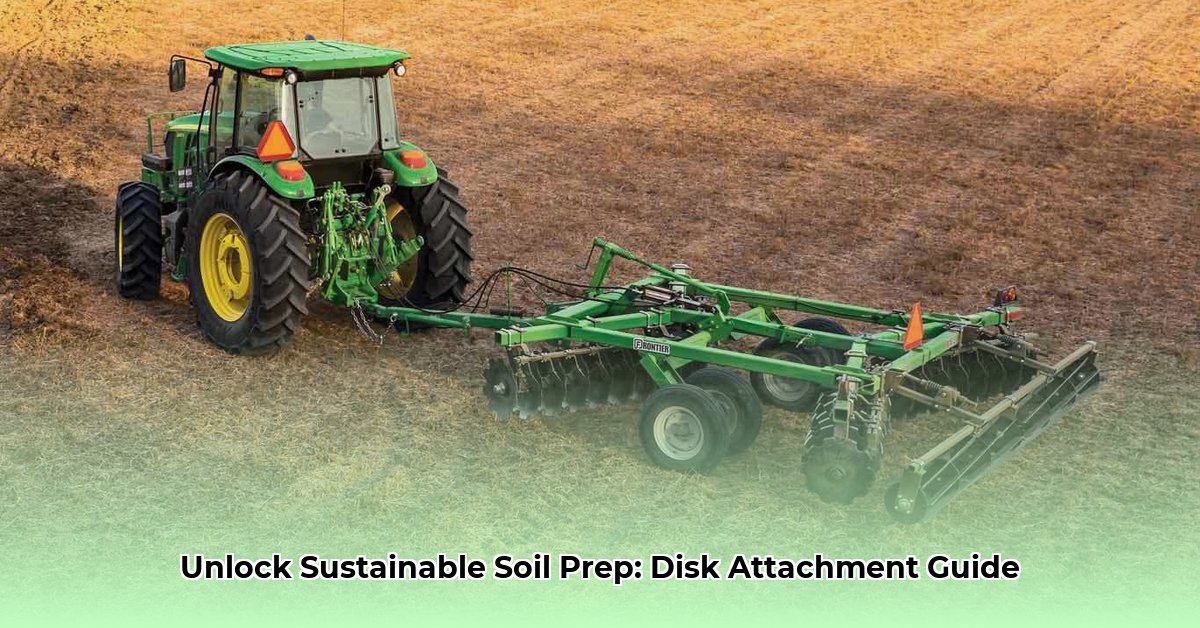
Getting your soil ready for planting is crucial for a successful harvest. A tractor disk attachment—a key tool for soil preparation—acts like a giant rotating rake, breaking up soil clumps, leveling the ground, and creating the perfect seedbed. But with numerous options available, selecting the right one can be daunting. This guide simplifies the process, empowering you to make an informed decision and contribute to more sustainable farming practices. We'll explore different types, factors to consider, proper usage, maintenance, and the role of sustainability. For more information on tractor attachments, check out this helpful resource.
Understanding Disc Harrows: The Workhorses of Soil Preparation
A disc harrow (or tractor disk attachment) is an agricultural implement designed to efficiently till the soil. Imagine a large, metal comb with spinning blades. These rotating discs cut and mix the soil, breaking up hard clods, smoothing the surface, and preparing it for planting. Two main types exist: angle iron and box frame.
Angle iron harrows: These are simpler, more budget-friendly options, ideal for lighter work in relatively easy soils and requiring less tractor power. They're durable enough for smaller farms or minimal tillage needs but typically offer less adjustability.
Box frame harrows: These are heavy-duty, offering greater adjustability. You can alter the disc angle and tillage depth, crucial for heavier, compacted soils or challenging terrain. While the initial investment is higher, their increased durability and performance often provide long-term savings.
Choosing the Right Disc Harrow: Matching the Tool to the Job
Selecting the right disc harrow depends on several key factors:
1. Farm Size and Soil Type:
Farm Size: Larger farms benefit from wider harrows to cover more ground quickly. Smaller farms may find narrower models perfectly suitable.
Soil Type: Heavy clay soils need robust harrows with heavier discs and more aggressive settings to break up and level the soil. Lighter soils, like sandy loam, may only require a lighter-duty harrow. Improper selection can lead to over-tilling and soil compaction. Do you need a heavy-duty machine for clay, or will a lighter model suffice for sandy loam?
2. Budget:
Angle iron harrows are generally more affordable, suitable for new farmers or those on a budget. They often suffice for less demanding soil conditions.
Box frame harrows, with their superior adjustability and durability, command a higher price. However, their longevity and performance in difficult conditions can lead to significant long-term cost savings. What's the optimal balance between initial cost and long-term value for your operation?
3. Adjustability:
- Box frame harrows usually offer far greater adjustability, allowing precise control over tillage aggressiveness and depth. This is invaluable for adapting to varying soil types and conditions. Angle iron harrows often have limited adjustability. How important is the ability to fine-tune your tillage process?
4. Tractor Horsepower:
- Ensure your tractor has sufficient horsepower to pull the chosen harrow effectively. Underpowering can lead to poor performance and strain on your tractor. Always check the manufacturer's specifications to ensure compatibility. Does your tractor have the power necessary to effectively operate the harrow you're considering? Is the cost of upgrading worth the better performance?
Proper Usage and Maintenance: Getting the Most Out of Your Investment
Proper usage and maintenance are crucial for extending the lifespan of your disc harrow. Following these steps will maximize your return on investment:
1. Pre-Operation Inspection: Before each use, thoroughly inspect for loose bolts, worn parts, and damage to discs or bearings. Addressing issues proactively prevents costly repairs.
2. Safe Operation: Maintain a safe speed, avoiding obstacles that can damage the harrow. Pay attention to ground conditions and adjust settings as needed.
3. Post-Operation Cleaning: Remove soil, debris, and weeds after each use to prevent build-up and corrosion. Consistent cleaning enhances performance and lifespan.
4. Regular Maintenance: Regularly lubricate moving parts and sharpen discs periodically to maintain cutting efficiency. Inspect bearings for wear and tear and replace as necessary.
Sustainable Practices: Integrating Your Disc Harrow into a Greener Farming System
Sustainable farming practices prioritize soil health and environmental responsibility. Here's how your disc harrow choice contributes:
Conservation Tillage: Minimizing soil disturbance reduces erosion and protects valuable topsoil. Proper disc harrow usage contributes to reduced tillage or no-till practices.
Fuel Efficiency: Using the right harrow minimizes fuel consumption, reducing operational costs and environmental impact. The right size and type significantly improve fuel economy.
Responsible Sourcing: Consider the materials and manufacturing processes. Supporting local manufacturers or choosing components from recycled or sustainably harvested materials reduces your carbon footprint.
Case Studies: Real-World Examples (Future Additions)
This section will be updated with real-world examples illustrating successful disc harrow usage in various farming contexts.
Choosing the right tractor disk attachment is a crucial decision impacting your farm's efficiency and sustainability. By considering the factors outlined above, you can confidently select a tool that contributes to bountiful harvests while minimizing your environmental impact. Remember, continual learning and adaptation are key to effective sustainable farming practices.